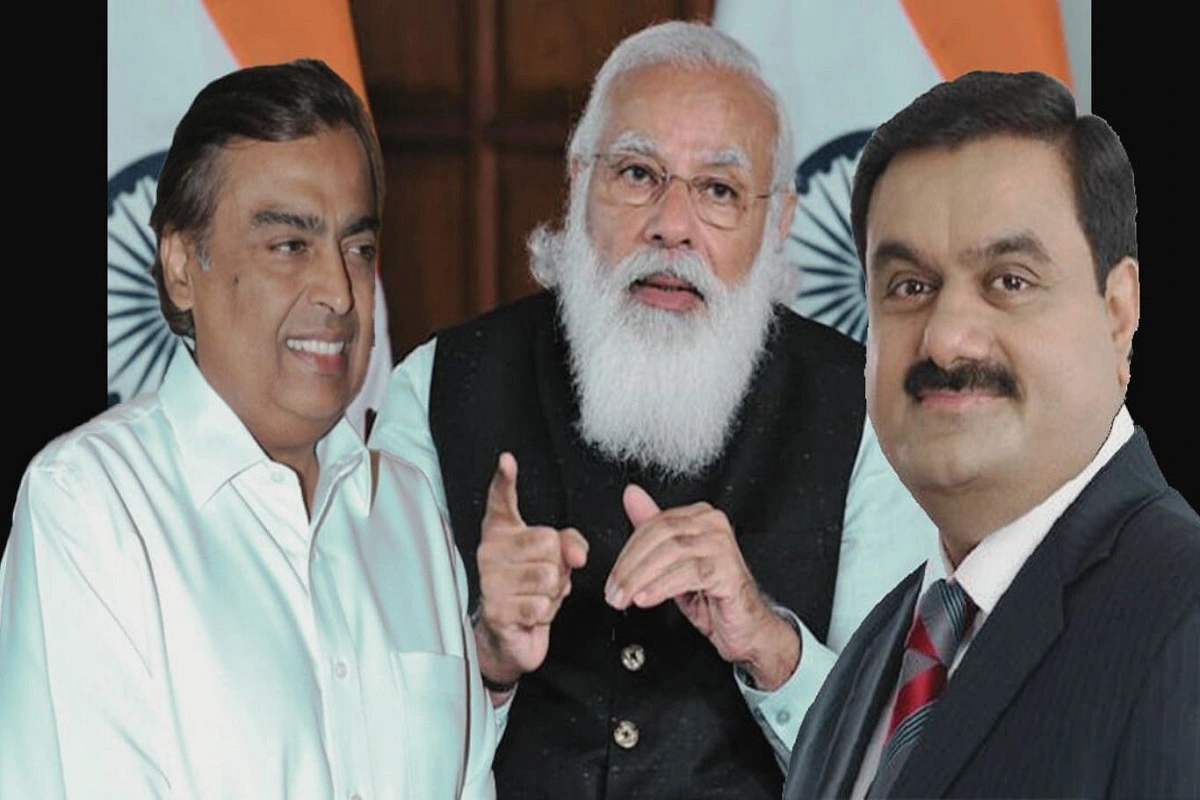
Narendra Modi's Nine-Year Rule: Fueling Growth Across Industries, Not Just Adani Or Ambani
Since assuming office in 2014, Narendra Modi’s leadership has brought about significant economic growth and development in India. While detractors often criticize his alleged close ties with industrial giants like Adani and Ambani, it is essential to recognize that his tenure has witnessed progress across all sectors of the Indian economy. From small and medium enterprises (SMEs) to large-scale industries, Modi’s policies have fostered a conducive environment for growth, encouraging entrepreneurship, and propelling India towards becoming a global economic powerhouse.
As we step into the tenth year of the Modi government’s tenure, the positive news resounds. Against all odds, India proudly boasts a splendid 7.2 percent GDP growth rate in 2022-2023, defying global skepticism. Our record-breaking GST collection of 1.57 lakh crore in May adds to the euphoria. International economic monitoring agencies, including the prestigious United Nations’ Global Economic Monitoring Branch and Moody’s credit rating agency, affirm India’s continued dominance in the global economy for the next five years. Despite initial hurdles like the COVID-19 pandemic, geopolitical tensions, and bold reforms such as demonetization and GST, the Indian economy shines as the crowning glory of the Modi government’s tenure. From the tenth-largest economy in 2014, we have ascended to the fifth-largest, surpassing the likes of Britain, France, Italy, Canada, and Brazil. This remarkable growth is a testament to Moidi’s unwavering dedication.
Boosting Infrastructure Development
One of the key pillars of Modi’s economic vision has been the focus on infrastructure development. The government’s ambitious projects like the “Bharatmala” and “Sagarmala” initiatives have significantly improved connectivity, bolstered logistics, and enhanced trade opportunities. These infrastructure investments have facilitated growth across industries, enabling businesses to expand their reach and tap into new markets.
The country witnessed fast-paced infrastructure development in all sectors in the last nine years. Over 53000kms of National highways were added with rural road connectivity increasing to nearly 99% coverage through the Pradhan Mantri Gram Sadak Yojana. The speed of highway construction has reached 37km per day. Indian railways also witnessed a massive capacity expansion through line doubling and electrification and the Vande Bharat Express, India’s first indigenous Semi High-Speed trains, is a major ‘Make in India’ success story.
Vande Bharat trains are already operational and 400 Vande Bharat express trains are to be manufactured in the next three years. In the last nine years, the metro rail projects have reached 20 cities. In the aviation section steps were taken to make it affordable and accessible through the Udan project. 74 new airports have been built and operationalized in the last 9 years. Further 111 waterways were declared as National Waterways. The country also witnessed major constructions during this period like the World’s highest railway bridge, the Chenab Bridge, the World’s longest highway tunnel, the Atal Tunnel, further the completion of many long-pending projects like the Saryu Nahar Irrigation Canal, Eastern, and Western Peripheral Expressway etc. Prime Minister Narendra Modi also announced the PM GatiShakti National Master Plan (NMP), with the aim of accelerating development activities in the country, institutionalizing holistic planning and inter-departmental coordination through a single integrated portal The recently implemented infrastructure development projects are accelerating the country’s journey towards becoming a developed nation by 2047.
Promoting Ease of Doing Business
Recognizing the need to make India an attractive investment destination, Modi’s government has implemented several reforms to improve the ease of doing business. Initiatives such as the Goods and Services Tax (GST) and the Insolvency and Bankruptcy Code (IBC) have streamlined taxation and bankruptcy processes, reducing bureaucracy and promoting transparency. These reforms have been instrumental in attracting both domestic and foreign investment across a wide range of sectors.
Modi administration repealed about 2,000 antiquated laws from the British era that had led to industrialists being imprisoned for relatively minor offences. India’s position in the World Bank’s annual ranking of countries for their ease of doing business jumped massively – from 142 to 63 in five years.
Empowering Micro, Small and Medium Enterprises (MSMEs)
Modi’s emphasis on the development of MSMEs has been a game-changer for the Indian economy. Recognizing their potential as engines of growth and employment, the government has implemented schemes like “Make in India” and “Startup India” to support and nurture these enterprises. Through increased access to credit, simplified regulations, and skill development initiatives, MSMEs have thrived, contributing to job creation, innovation, and economic diversification.
The MSME sector, with more than six crore enterprises, has emerged as a highly vibrant and dynamic sector of the Indian economy, fostering entrepreneurship and generating self-employment opportunities at comparatively lower capital cost, next only to agriculture. Ministry of MSME promotes growth and development of the sector, including Khadi, Village and Coir industries, by implementing various schemes/programmes towards credit support, technological assistance, infrastructure development, skill development and training, enhancing competitiveness and market assistance. Organizations under the Ministry include Office of Development Commissioner (MSME), Khadi and Village Industries Commission (KVIC), Coir Board, National Small Industries Corporation Ltd. (NSIC), National Institute for Micro, Small and Medium Enterprises (ni-msme) and Mahatma Gandhi Institute for Rural Industrialization (MGIRI). Ministry has a vast network of field formations spread across the length and breadth of the country to support and handhold MSMEs, which include MSME Development and Facilitation Offices (MSME-DFO), Branch MSME-DFOs, MSME Testing Centres, MSME-Testing Stations and Technology Centres (Tool Room & Technical Institutions) and field offices of KVIC, Coir Board and NSIC.
Revolutionizing Digital India
Under Modi’s leadership, the Digital India initiative has transformed the country’s digital landscape. Initiatives like the Aadhaar digital identification system, the Unified Payments Interface (UPI), and the Jan Dhan Yojana have facilitated financial inclusion, improved access to banking services, and accelerated the adoption of digital transactions. This digital revolution has catalyzed growth across sectors, promoting e-commerce, fintech, and digital services, creating new business opportunities and reaching previously untapped markets.
Fostering Entrepreneurship and Innovation
Modi’s government has actively promoted entrepreneurship and innovation through various programs and policies.
To foster innovation, the government has recognized the importance of investing in research and development. Funding for scientific research has been significantly increased, with a particular focus on key sectors such as healthcare, renewable energy, biotechnology, and space exploration. The establishment of research institutions and the promotion of public-private partnerships have facilitated collaboration between academia, industry, and the government, leading to breakthrough innovations and technological advancements.
The “Standup India” scheme, for instance, aims to facilitate bank loans to scheduled caste and scheduled tribe entrepreneurs.
The Atmanirbhar Bharat (Self-Reliant India) campaign, launched during the COVID-19 pandemic, aims to build a resilient and self-sufficient economy. It encourages domestic manufacturing, innovation, and the development of indigenous technologies. By promoting self-reliance, the government has created an environment that encourages innovation, reduces dependence on imports, and supports the growth of domestic industries, including the technology and manufacturing sectors.
Recognizing the importance of a skilled workforce in driving innovation, the government has prioritized skill development initiatives. Programs such as “Skill India” aim to equip the youth with industry-relevant skills, fostering an entrepreneurial mindset and encouraging innovative thinking. By bridging the skill gap, the government has empowered individuals to contribute to India’s innovation ecosystem and pursue entrepreneurial ventures.
Modi’s government has actively sought international collaboration and partnerships to foster innovation. Initiatives such as the “International Solar Alliance” and the “India-UK Tech Partnership” have facilitated knowledge-sharing, technology transfer, and joint research projects. By connecting with global innovators, academia, and businesses, India has been able to leverage international expertise and accelerate its innovation capabilities.
These initiatives have inspired a wave of entrepreneurial spirit and innovation, fostering the growth of startups and enabling India to emerge as a global hub for innovation and technology.
Strengthening Agriculture and Rural Development
Modi’s focus on agriculture and rural development has been crucial in ensuring holistic growth across the economy. Initiatives such as the Pradhan Mantri Kisan Samman Nidhi (PM-KISAN) scheme and the National Rural Livelihood Mission (NRLM) have provided direct financial assistance to farmers and enhanced rural livelihood opportunities. By investing in rural infrastructure, irrigation systems, and market linkages, the government has bolstered the agricultural sector, reducing poverty and improving rural incomes.
Initiatives such as Ujjwala Yojana (Free LPG Gas Connection Scheme), Ayushman Bharat Yojana (National Health Protection Scheme), Housing Scheme, Toilet Scheme, and welfare schemes providing economic benefits to farmers have transformed the living standards of countless families. Due to the integration of millions of people into the banking system, the government’s financial assistance is now reaching them directly and comprehensively through these schemes. The combination of Jan-Dhan Yojana (Financial Inclusion Scheme) and Aadhaar-Mobile linkage has been one of the major achievements of the government in bringing the poor into the formal financial system. Currently, approximately 50 crore people have bank accounts under the Jan-Dhan Yojana. Additionally, there is also a significant number of beneficiaries under the Mudra Loan Scheme and direct benefit transfer of subsidies. As a result, a large section of our society, not only in the mainstream but also in the marginalized communities, is not only uplifted but also hopeful for a brighter future. This is a significant achievement that cannot be measured on a physical scale.
Conclusion
Critics of Narendra Modi’s leadership often contend that his rule has disproportionately favored industrial giants like Adani and Ambani. However, a closer look at his tenure reveals a more nuanced picture of economic growth. By implementing policies focused on infrastructure development and equitable growth, Modi has laid out a level playing field for all kinds of businesses, both big and small.


















